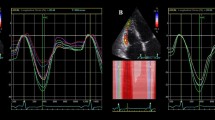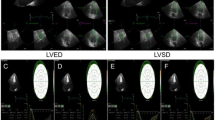Abstract
LV torsion during exercise in patients with coronary artery disease (CAD) is not well known. Circumferential strain (CS) and left ventricular (LV) torsion (Tor) have not been evaluated during ischemia in these patients. We aimed to assess the effect of ischemia during exercise echocardiography (ExE) on CS and Tor. We studied a group of 73 patients with true positive ExE results (Ischemic group: ischemia plus an abnormal coronary angiogram) and a matched control group of 66 patients with negative ExE and either normal coronary angiography or low post-test probability of CAD. Basal rotation (Rot) and apical rotation and basal and apical CS were studied by speckle tracking at rest and exercise. Apical CS and apical and basal Rot values were similar between groups at rest, except basal CS which was already worse in the ischemic group. At exercise, all rotational and CS parameters were impaired in the ischemic in comparison with the control group (basal CS: −18 ± 5 vs. −25 ± 7 %, p < 0.001; apical CS: −31 ± 11 vs. − 43 ± 9 %, p < 0.001; time to basal CS: 52 ± 6 vs. 48 ± 7 %, p = 0.001; time to apical CS: 55 ± 7 vs. 49 ± 6 %, p < 0.001; basal rotation: −0.7 ± 6.5° vs. −6.2 ± 8.5°, p < 0.001; LV twist 13.0 ± 10.4° vs.19.7 ± 11.5°, p < 0.001; LV-Tor 1.9 ± 1.6°/cm vs. 2.8 ± 1.7˚/cm, p = 0.001) with the exception of apical rotation which was similar (12.3 ± 7.4° vs. 13.4 ± 7.7°, p = NS). Basal and apical CS and basal rotation impair during exercise-induced ischemia. LV-Tor decreases with ischemia due to worsening of basal rotation, whereas apical rotation does not impair, suggesting the existence of an apical compensatory mechanism.







Similar content being viewed by others
References
Park SJ, Miyazaki Ch, Bruce CHJ, Ommen S, Miller FA, Oh JK (2008) Left ventricular torsion by two-dimensional speckle tracking echocardiography in patients with diastolic dysfunction and normal ejection fraction. J Am Soc Echocardiogr 21:1129–1137
Fuchs E, Muller MF, Oswald H, Thony H, Mohacsi P, Hess OM (2004) Cardiac rotation and relaxation in patients with chronic heart failure. Eur J Heart Fail 6:715–722
Maier SE, Fischer SE, McKinnon GC, Hess OM, Krayenbuehl HP, Boesiger P (1992) Evaluation of left ventricular segmental wall motion in hypertrophic cardiomyopathy with myocardial tagging. Circulation 86:1919–1928
Kido T, Nagao M, Kido T, Kurata A, Miyagawa M, Ogimoto A et al (2013) Stress/Rest circumferential strain in non-ischemia, ischemia, and infarction–quantification by 3 T tagged magnetic resonance imaging. Circ J 77:1235–1241
Nucifora G, Marsan NA, Bertini M, Delgado V, Siebelink HM, Van Werkhoven JM et al (2010) Reduced left ventricular torsion early after myocardial infarction is related to left ventricular remodeling. Circ Cardiovasc Imaging 3:433–442
Bertini M, Delgado V, Nucifora G, Ajmone Marsan N, Ng AC, Shanks M et al (2010) Left ventricular rotational mechanics in patients with coronary artery disease: differences in subendocardial and subepicardial layers. Heart 96:1737–1743
Helle-Valle T, Crosby J, Edvardsen T, Lyseggen E, Amundsen BH, Smith HJ et al (2005) New noninvasive method for assessment of left ventricular rotation: speckle tracking echocardiography. Circulation 112:3149–3156
Stuber M, Scheidegger MB, Fischer SE, Nagel E, Steinemann F, Hess OM et al (1999) Alterations in the local myocardial motion pattern in patients suffering from pressure overload due to aortic stenosis. Circulation 100:361–368
Moen CA, Salminen PR, Grong K, Matre K (2011) Left ventricular strain, rotation, and torsion as markers of acute myocardial ischemia. Am J Physiol Heart Circ Physiol 300:H2142–H2154
Peteiro J, Bouzas-Mosquera A, Broullon FJ, Garcia-Campos A, Pazos P, Castro-Beiras A (2010) Prognostic value of peak and post-exercise treadmill exercise echocardiography in patients with known or suspected coronary artery disease. Eur Heart J 31:187–195
Bouzas-Mosquera A, Peteiro J, Alvarez-Garcıa N, Broullon FJ, Mosquera VX, Garcıa-Bueno L et al (2009) Prediction of mortality and major cardiac events by exercise echocardiography in patients with normal exercise electrocardiographic testing. J Am Coll Cardiol 53:1981–1990
Lang RM, Badano LP, Mor-Avi V et al (2015) Recommendations for cardiac chamber quantification by echocardiography in adults: an update from the American Society of Echocardiography and the European Association of Cardiovascular Imaging. J Am Soc Echocardiogr 28:1–39.e14
Hoffmann R, Lethen H, Marwick T, Rambaldi R, Fioretti P, Pingitore A et al (1998) Standardized guidelines for the interpretation of dobutamine echocardiography reduce interinstitutional variance in interpretation. Am J Cardiol 82:1520–1524
Mor-Avi V, Lang RM, Badano LP, Belohlavek M, Cardim NM, Derumeaux G et al (2011) Current and evolving echocardiographic techniques for the quantitative evaluation of cardiac mechanics: ASE/EAE consensus statement on methodology and indications endorsed by the Japanese Society of Echocardiography. J Am Soc Echocardiogr 24:277–313
Ahmed MI, Desai RV, Gaddam KK, Venkatesh BA, Agarwal S, Inusah S et al (2012) Relation of torsion and myocardial strains to LV ejection fraction in hypertension. JACC Cardiovasc Imaging 5:273–281
Young AA, Kramer CM, Ferrari VA, Axel L, Reichek N (1994) Three-dimensional left ventricular deformation in hypertrophic cardiomyopathy. Circulation 90:854–867
Peteiro J, Bouzas-Mosquera A, Barge-Caballero G, Martinez D, Yanez JC, Lopez-Perez M et al (2014) Left ventricular torsion during exercise in patients with and without ischemic response to exercise echocardiography. Rev Esp Cardiol 67:706–716
Kroeker CAG, Tyberg JV, Beyar R (1995) Effects of ischemia on left ventricular apex rotation An experimental study in anesthetized dogs. Circulation 92:3539–3548
Knudtson ML, Galbraith PD, Hildebrand KL, Tyberg JV, Beyar R (1997) Dynamics of left ventricular apex rotation during angioplasty. A sensitive index of ischemic dysfunction. Circulation 96:801–808
Bansal M, Leano RL, Marwick TH (2008) Clinical assessment of left ventricular systolic torsion: effects of myocardial infarction and ischemia. J Am Soc Echocardiogr 21:887–894
Van Dalen BM, Vletter WB, Soliman OI, Ten Cate FJ, Geleijnse ML (2008) Importance of transducer position in the assessment of apical rotation by speckle tracking echocardiography. J Am Soc Echocardiogr 21:895–898
Funding
This work has been funded by the Project N RD12/0042/0069, integrated in the National Plan for Scientific Research, Development and Technological Innovation 2008–2011 and by the ISCIII—General Subdirection of Assesment and Promotion of the Research—European Regional Development Fund (FEDER).
Author information
Authors and Affiliations
Corresponding author
Ethics declarations
Conflict of interest
There is no conflict of interest to disclose.
Electronic supplementary material
Below is the link to the electronic supplementary material.
10554_2016_976_MOESM1_ESM.avi
Supplementary material 1. Video 1: Resting (on the top) and exercise (on the bottom) 2-D apical images of a patient with ischemic CAD. Note exercise-induced wall motion abnormalities in the three coronary artery territories. (AVI 8386 KB)
10554_2016_976_MOESM2_ESM.avi
Supplementary material 2. Video 2: Video 2. Resting (on the top) and exercise (on the bottom) 2-D images at the basal (on the left) and apical (on the right) level in the same patient of Video 1. Note how the increase in apical counterclockwise motion at the apex is already visually noticeable. Also, note the increased counterclockwise rotation at the basal level. See also corresponding Figs 3 and 4. (AVI 5556 KB)
10554_2016_976_MOESM3_ESM.avi
Supplementary material 3. Video 3. Resting (on the top) and exercise (on the bottom) 2-D images at the basal (on the left) and apical (on the right) level in another patient with ischemia on the left anterior descending coronary artery territory. Note the increased apical counterclockwise rotation with exercise and how the base of the heart changes from a clockwise to a counterclockwise rotation. See also corresponding Figs 5 and 6. (AVI 6678 KB)
10554_2016_976_MOESM4_ESM.avi
Supplementary material 4. Video 4: Resting (on the top) and exercise (on the bottom) 2-D images at the basal (on the left) and apical (on the right) levels in a patient with a completely normal exercise echocardiography study. See also corresponding Fig 7. (AVI 6972 KB)
Rights and permissions
About this article
Cite this article
Peteiro, J., Bouzas-Mosquera, A., Broullon, J. et al. Left ventricular torsion and circumferential strain responses to exercise in patients with ischemic coronary artery disease. Int J Cardiovasc Imaging 33, 57–67 (2017). https://doi.org/10.1007/s10554-016-0976-z
Received:
Accepted:
Published:
Issue Date:
DOI: https://doi.org/10.1007/s10554-016-0976-z




